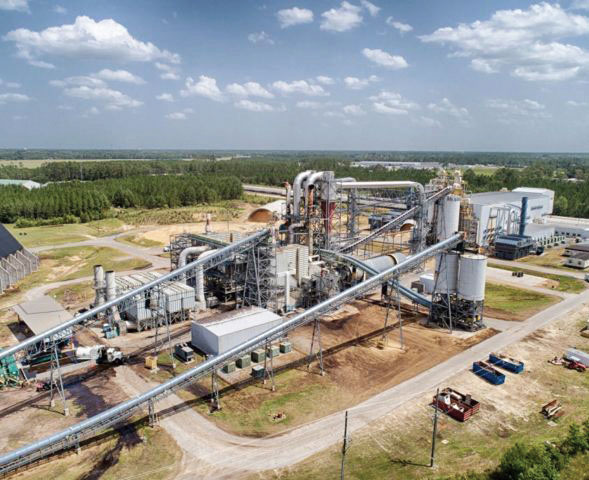Despite the pandemic, wood pellets are hitting home with both domestic and international customers.
The wood pellet industry is going great guns as the switch from hydrocarbons – particularly coal – to renewables is truly underway. As if to highlight just how much things have changed, GE, the world’s largest builder and operator of coal-fired systems, said it would not be building any more coal fired plants and would be switching their emphasis to renewables. Although wind and solar power systems have rightly garnered most of the attention, wood pellets – biomass density – are also growing at a rapid clip.
Pressing Business
The manufacture of wood pellets requires a number of steps. The raw biomass is first dried and the pellets are produced by compressing the wood material, which has first passed through a hammer mill to provide a uniform dough-like mass. This mass is fed to a press, where it is squeezed through a die having holes of the size required (normally 6 mm diameter, sometimes 8 mm or larger). The pelleting process effectively kills any fungal pathogens or insect pests, and the material is considered sanitary for export and trade. And being “sanitary” is key to any potential export of the pellets, especially to markets in Europe with ecological regulations.
And the Export Market is Booming
In 2019 the US exported around 1.9 million metric tonnes, up 14% over 2018. And wood pellet export volumes through the first five months of 2020 have out-paced the same period in 2019 according to Forisk Consulting. A quick look back and the potential pops out as exports have risen from about 1.9 million metric tonnes in 2012 to 6.9 million tonnes last year.
The United Kingdom is far and away the destination for US wood pellet exports. In 2019, the UK accounted for 78% of the U.S. wood pellet export volumes. In 2019, the UK imported 5.33 million metric tons of wood pellets from the U.S., a 13% year-over-year increase.
And export volumes are continuing to rise, although the pandemic economic hiccup has interrupted some plans. Export volumes to the UK are expected to continue to rise with the completion of MGT Power’s 299 MW CHP facility. But construction was halted in March, however, as a result of the coronavirus. Enviva Biomass, based in Bethesda, Maryland is the world’s largest supplier of wood pellets and had a contract to supply the MGT Power plant with one million metric tons of wood pellets annually. The UK is also the largest destination for Canada’s wood pellet exports, accounting for over 60% of the total.
Enviva is betting big on the continued rise of pellet fuel for electric generating stations – often as a replacement or co-fuel for coal fired plants. In August, the company completed the acquisition of an industrial scale wood pellet production plant in Waycross, Georgia, and associated contracted terminal capacity in Savannah, Georgia. The new facility has an annual production capacity of 800,000 metric tons per year and boosts the company’s annual capacity to 4.9 million metric tonnes. With the acquisition, Enviva’s operations in the U.S. Southeast now include nine wood pellet production plants and five deep-water export terminals across Virginia, North Carolina, South Carolina, Georgia, Alabama, Mississippi, and Florida.
Foreign markets
And it looks like Enviva is right. There are other promising markets for North American wood pellets.
Take Japan, for instance. Following the Fukishima nuclear disaster in 2011, virtually every kilowatt of electricity was generated by imported fuel – a large percentage of which was coal fired plants. The disaster triggered an energy policy change with an emphasis on renewables. And under the new “feed-in-tariff” system favoring renewables, like biomass density products, the Japanese market opened up to wood pellet shipments. Japan imported 1.44 million tons of wood pellets in 2019, up from 1.06 million tons in 2018 – a 36% increase –compared to 506,000 tons imported in 2017. Twenty coal fired power plants are reportedly being converted to handle wood pellets in the near term boosting Japan’s potential market.

Wood pellet export sales to the Netherlands also has the possibility of increasing. The Netherlands isn’t new to North American wood pellet imports. Back in 2012, the Netherlands imported over a million tons for power generation with a 60% U.S. market share of around 600,000 tons. But from 2013 to 2017, government subsidies were dropped and wood pellet imports fell. In 2018 Dutch government support for biomass fuel resumed and the Netherlands consumed an estimated 1.197 million metric tons of wood pellets in 2019, up from 614,000 metric tons in 2018. The Netherlands imported 1.223 million metric tons of wood pellets in 2019, with 130,000 metric tons of that volume coming from the U.S. Although it is difficult to analyze the impact of the pandemic, early estimates expect wood pellet imports to reach 2.5 million metric tons this year, with the U.S. accounting for up to 500,000 metric tons of the total volume. But it looks like wood pellet consumption should rise.
Early in September, Toyo Engineering Corp. announced on Sept. 2 it had been awarded a contract to construct the proposed wood pellet-fueled 75 MW Ichihara Yawatafuto Biomass Power Gogo Kaisha facility, located in Ichihara-shi, Chiba, Japan. The project is expected to be completed by 2023. According to Toyo, the project is the seventh order for biomass power plants ranging in size from 50 MW to 75 MW.
Besides Toyo, in August, Tokyo Gas Co. Ltd. subsidiary, Prominent Power Co. Ltd., announced plans to acquire the 75 MW Ichihara Yawatafuto Biomass Power GK project and a second 50 MW biomass power plant project from an Equis Group investment fund. Enviva is contracted to supply the facility with wood pellet fuel following its completion. In February 2020, the Tokyo Gas Co. said it had recently signed a 20-year take-or-pay contract to deliver 270,000 tons of pellets per year to the Ichihara facility beginning in 2023.





